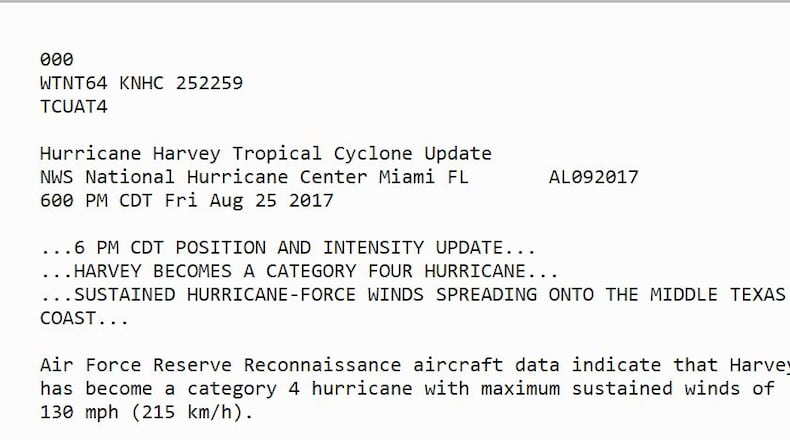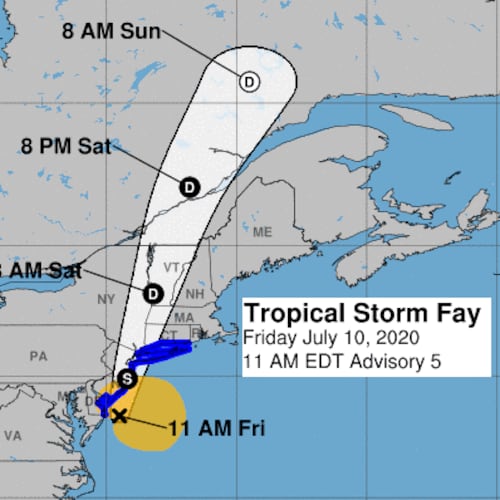While most of my 35 years as a radio reporter has been spent covering Congress, politics, elections, and news from Washington, D.C., I also managed to squeeze in a number of hurricanes over the years, and as many news organizations send people to Texas to cover Hurricane Harvey, there are a few things to keep in mind as you make that trek.
The first hurricane that I covered was Hugo, which blasted Charleston and ripped a big swath through the Carolinas. It was a different time in media, but the basics still apply. Flashlight. Batteries. Food. Drinks. Pen. Paper. Your equipment. And much more.
Here are some thoughts:
1. Don't try to be a hero. Yes, your bosses want great video of the storm, but it's not worth getting yourself killed by some piece of flying debris in order to showcase your work. When I covered hurricanes, my game plan was to hang around as things got ugly, go hunker down somewhere until the storm passed - and then emerge to catalogue the damage and the recovery efforts. One time down in Wrightsville Beach, North Carolina, I beat a hasty retreat back to the mainland, while a buddy of mine who is a producer for CBS News, stayed behind. Yes, he did get to come out of his hotel to experience the eye of the hurricane passing overhead. But he also got to watch his rental car float down the street when the storm surge arrived.
2. Always keep gas in the tank. When I went to cover Hurricane Hugo in September of 1989, veteran radio reporter Jerry Bodlander gave me several tips on how to cover a hurricane - one of them was to always make sure your gas tank didn't get too low. When the power goes out in areas hit by the hurricane, the pumps don't work any more. Jerry's rule was never let the tank go below half-full; I modified that to three-quarters. It was also a good way to stop off in another convenience store to chat with people who were out in the storm and get some interviews. One time in South Carolina, I remember being at a gas station when the police showed up to order the place to close down. I got my gas and headed up the road.
3. When you cover a hurricane, where do you eat? Often when I am on the road, it is to cover a political election, primary or caucus. You show up in some town, find a place to eat, a hotel to stay in, and you move on. But when you cover a hurricane, sometimes nothing is open. One of my favorite stops in the Carolinas was to go by a Piggly Wiggly - not only to get food and water - but also to do some interviews with people who were stocking up. My preferred food for a hurricane was to buy peanut butter and jelly and make endless sandwiches. Former ABC Radio reporter Vic Ratner gave me the tip for how to deal with your food and drink - keep several coolers in the trunk. I liked the three cooler approach - one for food, one for water and drinks, and one for beer. Not only do you have to cover the story, but you need to find a way to keep yourself fed as well.
4. What happens when cell systems go down? When I started covering hurricanes almost 30 years ago, you learned how to find a pay phone that was still working. I remember after Hugo, there was a phone near the North-South Carolina line north of Myrtle Beach that had a giant line of people, mostly members of the news media, trying to call their desk. Back then, that was the only way to get out. But now, when the cell phone systems go down because of power outages and more - how do you get your story back to your paper/website/station? As a reporter, you might want to keep an eye out for an old time phone booth - if they are hooked up directly to the phone system, you might have a chance to get that story back to your station. If not, then you have to start driving to somewhere with less damage in order to file your story. Cell system damage will be a big deal for reporters, first responders and residents of coastal Texas as well. Those systems are not fixed overnight.
5. The power of amateur radio. Along with being a radio reporter, I am also a licensed ham radio operator. Before cell phones and the internet, amateur radio was one way that weather reports were relayed to the National Weather Service during hurricanes; I would bring one of my radios with me, power it off the cigarette charger in the car, and pick up eyewitness reports - much like you might get now from Twitter and Facebook. In 2017, if the internet goes down, ham radio is still operating. If you are a reporter - and a ham - you might have an edge in reporting on Hurricane Harvey. It sure helped me, and I met others with that double along the way as well.
6. The power of social media. We haven't had a major hurricane hit the U.S. mainland since 2005. Things have come a long way since then in terms of Facebook, Twitter, Instagram and other sharing sites. Yes, cell phone networks will be turned upside down, but a lot of people will still be able to get out photos and more of what's going on, and what they are seeing out their windows. As a reporter, there is only so much you can see for yourself - social media expands that a great deal. It also provides a refresher course for those who decided to ride out the storm. This was from Hurricane Katrina.
7. Don't forget the story on local radio. While you are driving around as the storm approaches, don't forget to tune in to local radio stations. Many of them will change programming to focus entirely on the hurricane, sometimes sending out one station on multiple frequencies that are owned by the same company. I remember listening to one group of stations in South Carolina as Hurricane Hugo approached. The announcer said that they were turning off their broadcast so that all employees could go home and ride out the storm with their families. "See you on the other side," the man said, as dead air took over their FM frequency. This is also a way for me to remind you to bring along a battery powered radio - how many reporters have one of those sitting around? (Hint - I do.)
8. The biggest story is the aftermath and recovery. Yes, watching the storm come ashore in real time is a big deal. Doing stories where everyone is boarding up, the sound of hammers putting up plywood and hurricane shutters, talking to some of those who are having a hurricane party ("I'm always ready for a party") - those are important items to cover. But the most important thing is to emerge in the daylight after the storm arrives to show what happened, and to interview the survivors. That's when we get into the issue of disaster relief, and the difficulty of trying to get supplies to thousands and thousands of people, many of whom no longer have homes. Everyone has a story. Let them tell it. This CBS video below is from 25 years ago after Hurricane Andrew hit Florida - it is one of the best pieces of post-hurricane journalism that I have ever seen. You may not like Dan Rather, but he knew how to tell the story of those who survived a major storm like few others on TV.
About the Author
The Latest
Featured



